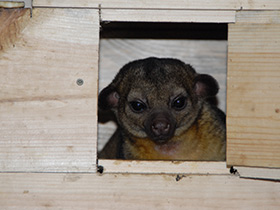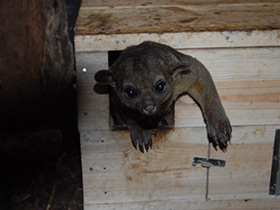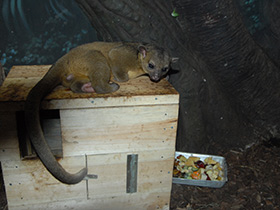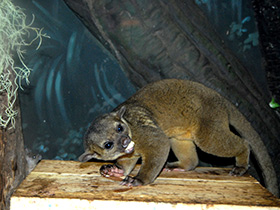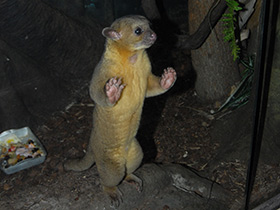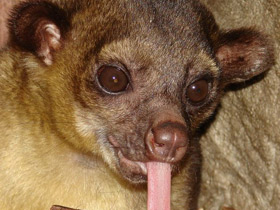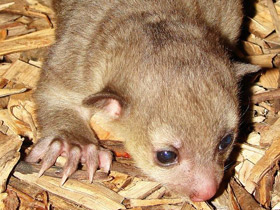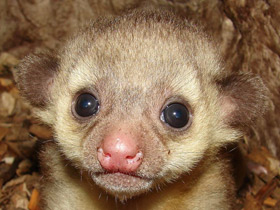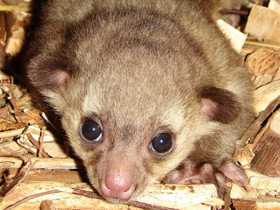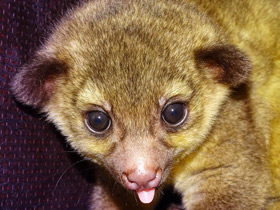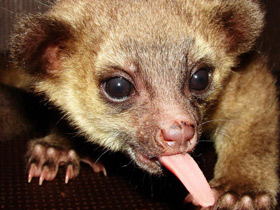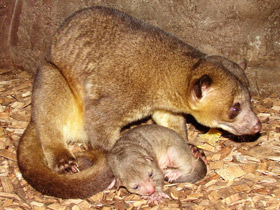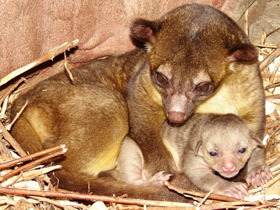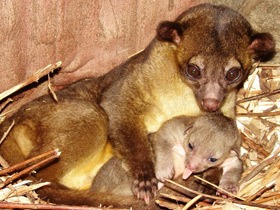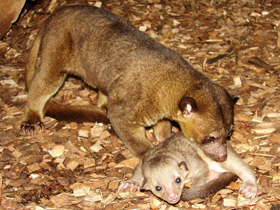The kinkajou (Potos flavus)
The kinkajou (/ˈkɪŋkədʒuː/ KING-kə-joo; Potos flavus) is a tropical rainforest mammal of the family Procyonidae related to olingos, coatis, raccoons, and the ringtail and cacomistle. It is the only member of the genus Potos and is also known as the "honey bear" (a name that it shares with the unrelated sun bear). Kinkajous are arboreal, a lifestyle they evolved independently; they are not closely related to any other tree-dwelling mammal group (primates, some mustelids, etc.).
Native to Mexico, Central and South America, this mostly frugivorous mammal is not an endangered species, though it is seldom seen by people because of its strict nocturnal habits. However, it is hunted for the pet trade, for its skin (to make wallets and horse saddles), and for its meat. The species has been included in Appendix III of CITES by Honduras, which means that exports from Honduras require an export permit, and exports from other countries require a certificate of origin or of re-export. They may live up to 40 years in captivity.
Appearance and lifestyle
Potos flavus is a species of carnivorous mammal of the family Procyonidae.
It has other common names, such as night monkey (not to be confused with monkeys of the genus Aotus), bush dog, cuchumbí, cusumbí, lion monkey, cuchicuchi (in Venezuela), huasa, martilla, michi monkey, cuyuso, cusumbo (in Ecuador) or night monkey (in Bolivia).
Potos flavus is a striking cat-sized animal that zoologists originally classified as a primate because of its sticky tail, forward-facing eyes and love of fruit. Potos flavus has a rounded head, large eyes and round, wide-set ears (photo 1, 2, 3 ).
The tenacious and muscular tail of the Potos flavus is used as a safety belt, clinging to a strong branch, and as a balancer, when at night, in complete darkness, it climbs quickly from tree top to tree top, making great leaps if necessary. Potos flavus can also hang upside down, clinging to a branch with its tail and releasing its nimble forelegs to manipulate food objects. These animals are exclusively arboreal; they rarely descend to the ground. During the day, they often sleep in tree hollows or simply lie on branches, and up to 5 animals may congregate in one place.
Nutrition
Potos flavus means "honey bear" in the Ojibwe Indian language. They are very fond of honey and sometimes raid bee hives with their long (about 13 cm) and slender tongues.
Their diet consists of 90% of various fruits, of which the fastidious little bees always choose the freshest and ripest, and 10% of leaves, honey and nectar. In some parts of its range, Potos flavus also feeds on insects, frogs, lizards and bird eggs.
Social behaviour and reproduction
The social structure of Potos flavus is rather unusual: the family consists of two males, a female, their young up to 1 year old and the older offspring. They nurse, care for and sleep together, but always hunt alone. When the female is about 3 years old, she leaves her family. Territory is passed down from father to sons, as males are more closely related to each other.
These animals have unique glands on their chin, throat and chest that produce a scent secret with which they mark their territory. The reproduction rate of Potos flavus is very low, with females having only one (rarely two) offspring every two years. Potos flavus has virtually no enemies (apart from humans), but the deforestation situation in the Amazon rainforest may pose a threat of extinction for this species. Potos flavus are perfectly tame and adapt to those who care for them.
Etymology
The common name "kinkajou" derives from French: quincajou, based on the Algonquian name for the wolverine. It is similar to the Ojibwe word kwi·nkwaʔa·ke. Its other names in English include honey bear, night ape, and night walker. Throughout its range, several regional names are used; for instance, the Dutch names nachtaap, rolbeer, and rolstaartbeer are used in Suriname. Many names come from Portuguese, Spanish, and local dialects, such as jupará, huasa, cuchi cuchi, leoncillo, marta, perro de monte, and yapará.
Taxonomy
A. M. Husson, of the Rijksmuseum van Natuurlijke Historie (Leiden), discussed the rather complicated nomenclature of the kinkajou in The Mammals of Suriname (1978). In his 1774 work Die Säugethiere in Abbildungen nach der Natur, Schreber listed three items under the name "Lemur flavus Penn.": on page 145 is a short translation of Pennant's description of the yellow maucauco (later identified to be Lemur mongoz, presently known as the mongoose lemur) from his 1771 work A Synopsis of Quadrupeds (page 138, second figure on plate 16); on plate 42 is a depiction of the yellow maucauco by Schreber; the last item is a reference to A Synopsis of Quadrupeds itself. Husson noted that the last item is actually Pennant's description of an animal that is clearly a kinkajou. Husson therefore concluded that Lemur flavus is actually a "composite species" based on Schreber's specimen of the mongoose lemur and Pennant's specimen of the kinkajou, and identified the latter as the lectotype for the species.[7] The type locality reported by Schreber for L. flavus ("the mountains in Jamaica") was clearly based on Pennant's description of the kinkajou, who claimed, however, that his specimen was "shown about three years ago in London: its keeper said it came from the mountains of Jamaica". This error was pointed out by Thomas in 1902, who corrected the type locality to Suriname. He used the name Potos flavus for the kinkajou. The genus Potos was erected by Saint-Hilaire and Cuvier in 1795, with the type species Viverra caudivolvula described by Schreber in 1778 (later identified as a synonym of Potos flavus). In 1977 the family Cercoleptidae was proposed with the kinkajou as the sole member, but this classification was later dismissed.
Subspecies
Eight subspecies have been proposed (type localities are listed alongside):
- Potos flavus chapadensis J. A. Allen, 1904: Chapadas of Mato Grosso (Brazil);
- Potos flavus chiriquensis J. A. Allen, 1904: Boquerón, Chiriquí Province (Panama);
- Potos flavus flavus (Schreber, 1774): Suriname. Synonyms include Cercoleptes brachyotos, C. brachyotus, Mustela potto, and Viverra caudivolvula;
- Potos flavus megalotus (Martin, 1836): Santa Marta (Colombia);
- Potos flavus meridensis Thomas, 1902: Mérida (Venezuela);
- Potos flavus modestus Thomas, 1902: Montes Balzar, Guayas Province (Ecuador);
- Potos flavus nocturnus (Wied, 1826): São Miguel dos Campos, Alagoas (Brazil);
- Potos flavus prehensilis (Kerr, 1792): Veracruz (Mexico).
A 2016 phylogenetic study based on mitochondrial gene cytochrome b analyzed kinkajou specimens from a variety of locations throughout most of their range. The results showed 27 haplotypes split into five clades corresponding to geographical divisions: Costa Rica (clade 1), northern Brazil and the Guianas (clade 2), northern Peru (clade 3), Ecuador and Panama (clade 4), interfluves between the Branco River and Rio Negro in the Brazilian Amazon, low-lying Amazonian areas (in Bolivia, western Brazil and Peru), and eastern Atlantic Forest (clade 5). Given the diverse clades, the researchers suggested that some of the subspecies might be independent species.
As pets
Kinkajous are sometimes kept as exotic pets. They are playful, generally quiet, docile, and have little odor, but they can occasionally be aggressive. Kinkajous dislike sudden movements, noise, and being awake during the day. An agitated kinkajou may emit a scream and attack, usually clawing its victim and sometimes biting deeply. In 2011, the Centers for Disease Control and Prevention reported that pet kinkajous in the United States can be carriers (fecal–oral route) of the raccoon roundworm Baylisascaris procyonis, which is capable of causing severe morbidity and even death in humans if the brain is infected. In 2023, National Geographic reported that escaped kinkajous pets were living in Florida.
In El Salvador, Guatemala, and Honduras, pet kinkajous are commonly called micoleón, meaning "lion monkey". In Peru, pet kinkajous are frequently referred to as lirón, often described as a "bear-monkey". These names reflect its monkey-like body and obviously carnivoran head.
They typically live about 23 years in captivity, with a maximum recorded lifespan of 41 years.

















